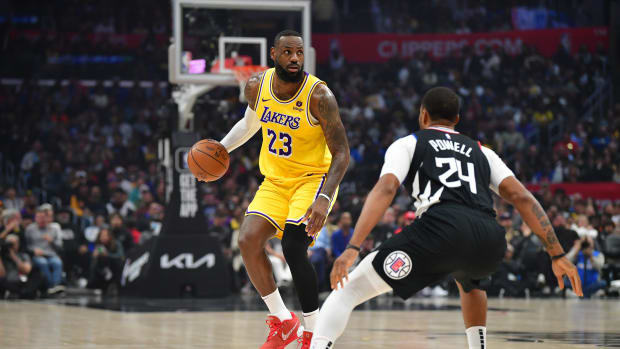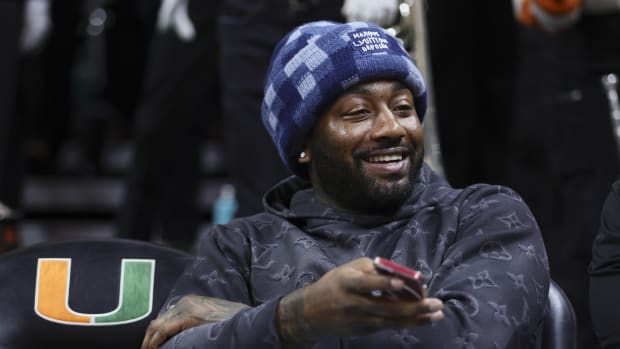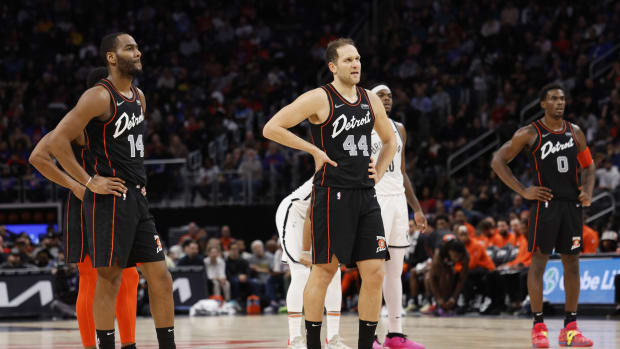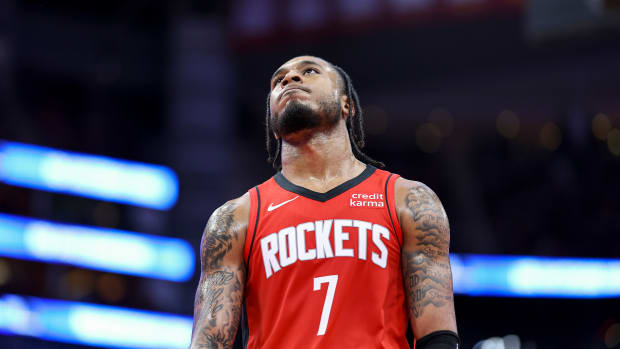When It Comes to Defenses, Stephen Curry Has Seen It All
There is no surer sign of a superstar than his opponent’s willingness to get weird. NBA coaches are creatures of habit, and if not habit, then some even more deeply held philosophy. Many are loathe to change beyond a few pre-negotiated options. Yet wherever Stephen Curry goes, he inspires defenses to abandon what is comfortable for what is necessary. Traditional centers are marginalized. Familiar coverages—the very systems that teams work all year long to perfect—are cast aside. Rather than stand on their defensive principles, most will throw strategies at the wall in the hope that some might stick. Frankly, it’s deserved. Not only is Curry as good as the defensive experimentation around him would advertise, but the needs in guarding him are worlds different from what comes standard.
Toronto’s endeavor to oddity began in earnest during Game 2 of the Finals, when Nick Nurse deployed his team in a box-and-one. Four defenders set up along the corners of the paint, building the box, while Fred VanVleet tracked Curry exclusively. Zone defense is no longer an NBA outlier, but this particular version is; for as much as defenses would like to neutralize an opponent’s best player, few are willing to concede so much as to run a four-man zone. In this case, the novelty was the point. After most of their other options had run their course, the Raptors tried a style so extreme that even Curry and the Warriors wouldn’t be experienced in solving it.
“The whole fourth quarter, they were playing some janky defense, just trying to send bodies to me everywhere,” Curry said in a postgame interview. “And our whole roster just took advantage of it.”
That isn’t explicitly true. When the Raptors were at their jankiest, they managed to hold the Warriors scoreless for five minutes and 32 seconds—nearly enough to complete a 12-point, fourth-quarter comeback. Even when Andre Iguodala knocked down a wide-open three to put the game away, it came by beating an outright trap of Curry near halfcourt rather than getting the better of the gimmick. Golden State, short both Klay Thompson and Kevin Durant, had honest trouble in breaking down the box-and-one because that particular junk defense saw them as they were: a team with only one truly threatening scorer.
This isn’t to say that the box-and-one could hold to scrutiny, or even that Toronto will resume playing it at all. A defense like this degrades as soon as it’s brought into the open air; once an opponent knows that it’s coming, it is almost guaranteed to fail. The half-life of this sort of defense is too short to withstand a playoff schedule. Within hours of the game, the Warriors staff will have already pulled film of any problem possessions for review. By the following morning, Kerr and his coaches will have devised some counters, and with the time time practice in between games, will have deployed them. It wasn’t just the box-and-one that worked in Game 2, but the shock of its revelation more than 40 minutes into the game. Golden State already had its hands full adjusting to lineups without Thompson, and then was confronted with a radical change in scheme.
Toronto is a team keen enough to bounce between defensive approaches, often without specific instruction. If Kawhi Leonard, Marc Gasol, or Kyle Lowry senses an opportunity, they can act on it while trusting their teammates to react. This was more deliberate, though reliant on the same acumen. With a chance to take a 2-0 lead in the NBA Finals, Nurse felt comfortable shifting his team into a defense that may not have seen a second of action all season. Considering the rarity of the box-and-one at the professional level, it’s possible that those executing it in a game for the first time in a decade. That it worked as well as it did and Toronto couldn’t complete its comeback feels costly, in retrospect.
As a team, you only get so many of these surprises—and even fewer against the Warriors. Playing in the Finals for five straight years means seeing almost everything. If there’s a way to target Curry on either end of the floor, Golden State has likely survived it. Toronto can only win by moving on. Keep the box-and-one in the air as a possibility, perhaps for the moments when Thompson is out of the game. Even then, it’s not as if the Warriors can’t find good looks against a defense that bends so overtly toward Curry. Some in Game 2 simply rimmed out:
Should the tactic continue, Cook—a bit player under most normal circumstances—will prove valuable. Beating the box-and-one doesn’t take a superteam, but it does require a few key ball-handlers. Force the defense to commit, keep the ball moving, and good looks should materialize. More conventional defenses have forced Cook to make plays throughout this postseason. He has responded with impressive calm.
The most important weapon against Curry is a player who can pressure the ball like VanVleet, and the most important scheme is a full array. Prior to its dalliance in zone, Toronto began the second half by switching more to contain Curry, having largely either trapped him or met him at the level of the screen in the first half. Both VanVleet and Danny Green (who starts the game on Curry) picked him up full-court, keeping the former MVP accountable to both the eight-second count and his every dribble. The pressure on Curry rarely changes. It’s the coverage of everyone else that dictates the changes in what he sees. If there are two teammates on the wings who can be left open, a Curry drive might be met with two huge defenders at the rim:
Before the Raptors even moved to an explicit box-and-one, they were effectively playing one by edging in toward the lane. When he cut down the middle on this possession, Curry brought four Raptors into the paint with him—despite the fact that he didn’t even have the ball:
It took everything Curry had to keep the ball from VanVleet and Leonard, much less to actually do anything productive with it. This is the kind of attention that Curry has seen throughout the Finals, and it will only grow more pointed if Thompson (who was announced as questionable for Game 3) is unable to go. What’s unique about the Warriors is that it all feels so volatile, as if they’re never more than a few minutes away from busting any defense. This is a team that, with its best player swarmed, assisted on 34 of its 38 field goals in a game with little margin for error. No player gives an offense more momentum than Curry, and few connect the dots from pressure to bucket as well as Green and Iguodala.
There will be layups for Shaun Livingston, loose rebounds for Alfonzo McKinnie, and stray lobs for Andrew Bogut. It’s all the cost of doing business where Curry is concerned, even on a night where he scores 23 points in 41 minutes. All a defense can do is the same it did with prime LeBron or Shaq at the height of his powers: put the best personnel available on the floor and trust in the kitchen sink.


































